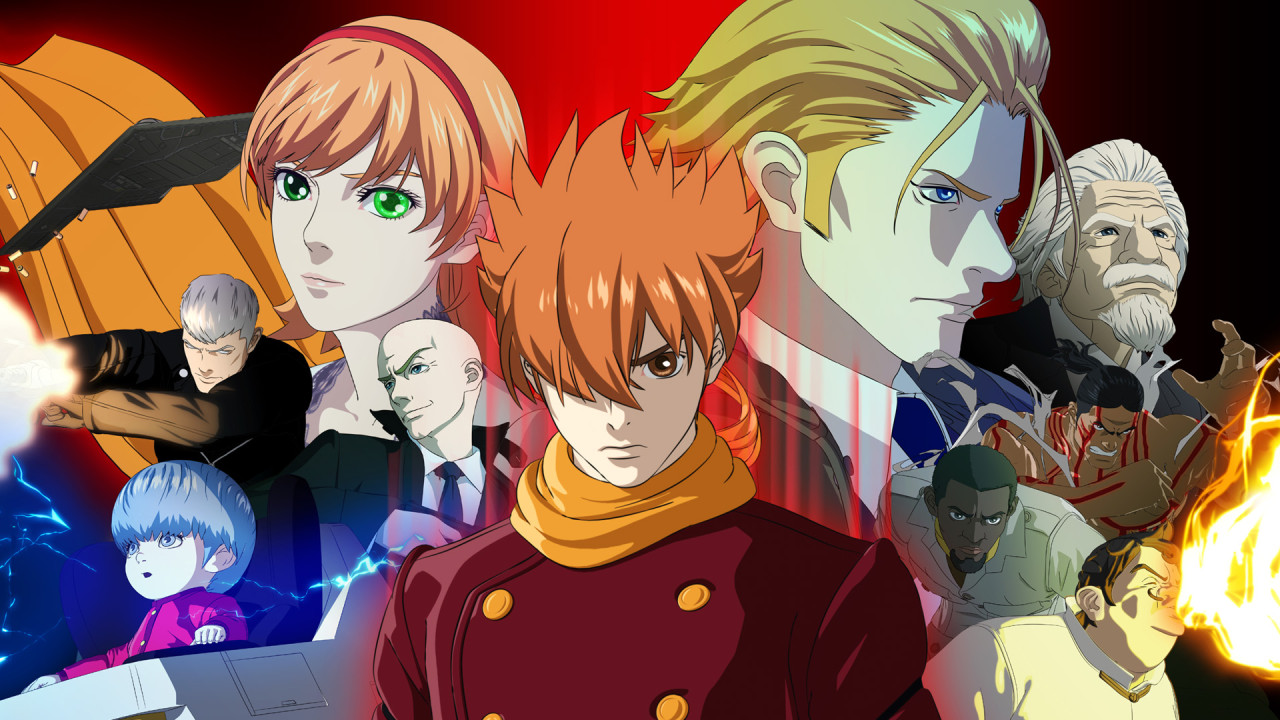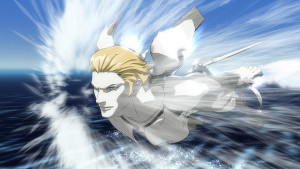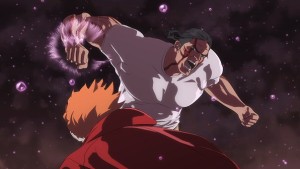Animating Cyborg 009
June 10, 2015 · 1 comment
By Andrew Osmond.
 A cyborg is a creature which combines the mechanical and the organic. 009 Re: Cyborg is about cyborgs, as you’d expect from the name, but you could also argue the film is a cyborg, yoking together rival traditions of animation; traditionally drawn animation, going back to Snow White and Astro Boy, and the CG animation popularised by Pixar and DreamWorks.
A cyborg is a creature which combines the mechanical and the organic. 009 Re: Cyborg is about cyborgs, as you’d expect from the name, but you could also argue the film is a cyborg, yoking together rival traditions of animation; traditionally drawn animation, going back to Snow White and Astro Boy, and the CG animation popularised by Pixar and DreamWorks.
Directed by Kenji Kamiyama, famed for helming Ghost in the Shell Stand Alone Complex – more cyborgs! – 009 Re: Cyborg was made (at least largely) in CGI. However, it was treated to look like a traditionally-drawn animation, similar to action classics like Akira and Ghost in the Shell. But unlike them, RE: Cyborg 009 was released in 3D, in line with many of today’s computer animations.
While Disney has made 3D retrofits of some of its traditional cartoons (e.g. 1991’s Beauty and the Beast), 009 Re: Cyborg is an ingenious reversal; a traditional-looking film created with the dimensionality of computer animation, so that its spectacle is more in tune with current tastes. It also has the practical advantages of CGI.
“First of all,” says Kamiyama, “the opportunity for trial and error [in CG] is an advantage compared to hand-drawn anime. Redoing the movement and acting again and again at the animatics (rough animation) stage brushed up the film, and that is difficult in hand-drawn animation.” Kamiyama cites a scene involving a crowd of enemies. It “could not have been done in such density with that time frame if they were hand-drawn. And when they’re done, characters can be re-used. I really felt how much the quality of animation is raised if the characters aren’t binned… I thought this will be a saving for the next time.” (You can recycle hand-drawn animation – see this Disney clip – but CGI is far more flexible.)
 However, Kamiyama found himself running up against a familiar problem with CG in film today. Namely, that it’s so much harder to impress an audience with CG spectacle. Imagine a piece of shock-and-awe traditional animation like this or this remade in CGI; it’s hard to imagine it being as awesome. According to Kamiyama, “CG is a technique wherein the effort of the creative side does not show.” At least not without tweaks, such as making sure that the characters in a mass attack have convincingly different physiques and movements. “These things need to be thorough in order for the audience to notice the effort, to think of it as refined.”
However, Kamiyama found himself running up against a familiar problem with CG in film today. Namely, that it’s so much harder to impress an audience with CG spectacle. Imagine a piece of shock-and-awe traditional animation like this or this remade in CGI; it’s hard to imagine it being as awesome. According to Kamiyama, “CG is a technique wherein the effort of the creative side does not show.” At least not without tweaks, such as making sure that the characters in a mass attack have convincingly different physiques and movements. “These things need to be thorough in order for the audience to notice the effort, to think of it as refined.”
Kamiyama learned that designs which look fine in traditional anime – even a CG-enhanced anime – often don’t work in straight CG. Kamiyama’s anime are set in realistic worlds with human characters (Stand Alone Complex, Moribito, Eden of the East). However, hand-drawing still allows a license for caricature which just doesn’t work in CG.
“For example,” Kamiyama says, “if we made a (CG) model with the head and body balance of the characters in Eden of the East and put the character in a car, the head would be too big and the character would look like a giant… (CG) animators tend to go towards what I call the realistic style of the 1980s; a smaller head and longer body to make (the characters) look cool. Every time the modeling was updated, they moved that way, especially with Jet and Great [two of the cyborg characters in the film]. In hand-drawn figures, that can look somehow okay but in CG it doesn’t. Compared with a realistically proportioned person, they are obviously people from a different planet.”
Another example: in Eden of the East, the cars in the anime were made shorter so that they looked more manga-ish. To do the same in 009 Re: Cyborg would have meant redesigning the film from scratch to make it feel consistent. “So I pondered what kind of style would be possible to complete this film,” said Kamiyama, “and went for a realistic style, which was more pragmatic.”
Kamiyama also thinks that the 3D format makes a difference. He argues that such films “have more information in each shot. With a normal TV or 2D films, this tempo should allow for a decent breathing space, but when watching it in 3D, I felt each shot was too short. Mr (Atsuki) Sato, who did all the editing with me, said the amount of information was so much that he felt like he was simply watching image after image appearing on the screen.”
It’s worth noting, though, that 3D may just amplify existing differences between animation and live-action. The late Satoshi Kon (Perfect Bue) claimed that if he’d made a film in live-action, his editing would have been too fast for audiences. In anime, Kon argued: “You reduce the amount of unnecessary information and gather what is necessary. The amount of information is less than that of a photograph, but the efficiency of communication is higher.”
 A parallel between Kon’s work and 009 Re: Cyborg is that neither use many ‘establishing’ shots, which are meant to ease the viewer into a new scene and setting. Kon cut them to disorientate the viewer, as you can see if you watch Perfect Blue. Kamiyama cut them because such shots would require more props to be modelled in 3D, a terribly time-consuming process. “When I want to slow the time, I tend to film props rather than the background,” he says. But in the 3D CG format of Re: Cyborg 009, he admits that “Simple things like ‘I want a [shot of a] plastic bottle,’ are totally impossible.
A parallel between Kon’s work and 009 Re: Cyborg is that neither use many ‘establishing’ shots, which are meant to ease the viewer into a new scene and setting. Kon cut them to disorientate the viewer, as you can see if you watch Perfect Blue. Kamiyama cut them because such shots would require more props to be modelled in 3D, a terribly time-consuming process. “When I want to slow the time, I tend to film props rather than the background,” he says. But in the 3D CG format of Re: Cyborg 009, he admits that “Simple things like ‘I want a [shot of a] plastic bottle,’ are totally impossible.
“Even props that appear for a moment have to be modeled from scratch,” Kamiyama adds. “For that reason, the cost performance of establishing shots is very bad… Also, it is difficult to use a slow camera movement to create breathing space, which is common in a TV series. If I try to move a camera [in 3D], the room itself needs remodeling. That is too much work.”
Despite such problems, 009 Re: Cyborg is an important step in the ongoing fight to make animation which combines the appeal of CG and trad animation. As the critic Robbie Collin put it in a Telegraph article, it’s the quest to imbue “tangible, weighty, intricate computer-generated imagery with the ineffable ‘living’ quality of hand-drawn cartoons – their flicker, intimacy, warmth and expressive energy.” It’s a pressing issue, given how many old-school cartoons are now being turned into CGI, with Stand By Me Doraemon and Harlock Space Pirate in Japan, and bids to make Snoopy and (maybe) Popeye in America.
As Collin notes, some of the most ambitious work in this area has been done by Disney, especially in its quietly spectacular short film Paperman which won the 2013 Oscar (unofficial copy here). As Collins explains, Paperman “was created with a new piece of software that allows animators to draw two-dimensional freehand lines, via a tablet and stylus, directly into a three-dimensional digital space… The upshot is simple: the hand of the artist and the art itself become close again.”
As Collins goes on to note, this approach may enter feature animation soon. Disney’s 2016 movie Moana, set in the South Pacific, will be much “more like hand-drawn animation” than other CG Disneys, according to John Lasseter. “But it’s technically considered a CG film,” Lasseter adds. “We are merging worlds.” With Disney and Production I.G singing from the same cyborg hymn-sheet, will a smart PR person get them to pool their resources? We’d love to see a cyborg Mickey…
Andrew Osmond is the author of 100 Animated Feature Films. 009 RE: Cyborg is released as a UK Limited Edition Blu-ray/DVD set by Anime Ltd on 14th September 2015.
Jose Ole
May 27, 2023 2:46 pm
The characters look so weird in this! 002 is missing his nose, 006 looks like Tarkov box art, 008 has a ridiculous beard, and 004 looks like he aged 20 years. It's like that western version of Sailor Moon they were thinking of releasing in the 90s, or the saturday morning Darkstalkers cartoon.